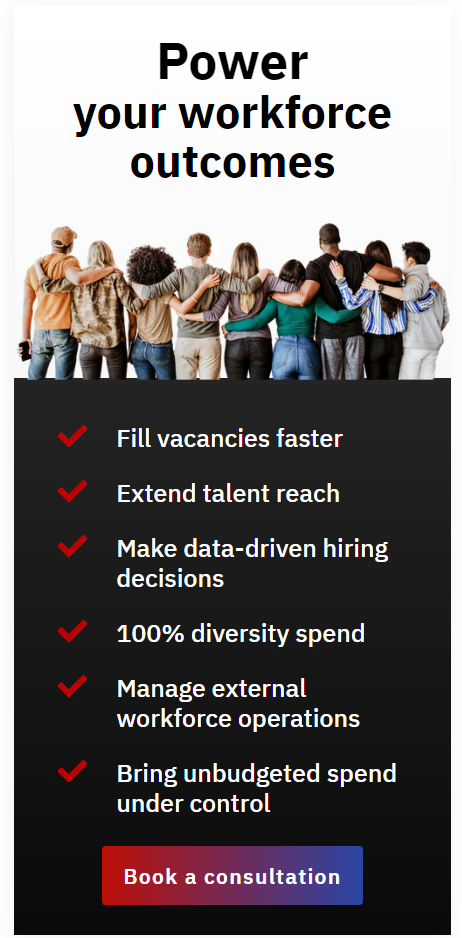Published : July 30, 2024
Improving Contingent Workforce Management: Streamlining Your Flexible Talent Ecosystem
In our previous discussion on the managed contingent workforce strategies, we emphasized its potential to enhance agility, achieve cost efficiencies, and access specialized skills. With businesses increasingly adopting flexible talent models, adept management of contingent workers is now paramount. This continuation delves into optimizing such management strategies to help businesses fully leverage this dynamic talent pool.
Today, the contingent workforce constitutes a significant and expanding segment of the labor market, comprising 20-30% in developed economies. This underscores their crucial role in modern business operations. As organizations look to augment their use of contingent workers, effective management strategies are indispensable to harness their full potential and address the evolving challenges in workforce dynamics.
Revolutionizing Contingent Workforce Management
Continuous Learning and Development
With rapid technological advancements, particularly in AI and automation, the need for continuous learning is more important than ever. Contingent workers, like full-time employees, must regularly update their skills to stay relevant. Employers should foster a culture of continuous learning, providing opportunities for both internal and external workers to upskill and adapt to new technologies and methodologies.
Integration of AI in Workforce Management
AI is revolutionizing workforce management by automating tasks such as resume screening, interview scheduling, and performance tracking. AI-driven platforms can optimize scheduling and workforce allocation of contingent workers. This integration not only streamlines operations but also provides valuable insights into workforce utilization and productivity.
Emphasis on Compliance and Risk Management
Navigating the complex landscape of labor laws and regulations is a significant challenge. Misclassification of workers can lead to severe legal and financial repercussions. Organizations must ensure compliance with relevant employment laws, including tax regulations, wage and hour laws, and anti-discrimination statutes. Implementing robust compliance frameworks and leveraging technology for regular audits can mitigate these risks.
Strategies for Effective Contingent Workforce Management
Centralizing Workforce Planning
To manage a contingent workforce effectively, it’s essential to centralize workforce planning. This approach integrates planning efforts across departments, aligning contingent talent with business objectives. Centralization offers a comprehensive view of workforce needs, enabling optimal resource allocation and the ability to anticipate future talent demands. Implementing a robust Workforce Management System is crucial, as it provides a unified view of the workforce, facilitating efficient resource allocation and real-time data-driven decision-making. Additionally, developing holistic talent strategies that incorporate both contingent and full-time employees ensures that hiring and deployment decisions are made with a complete understanding of the organization’s needs.
Automating Onboarding Processes
Efficiently onboarding contingent workers is critical for their rapid integration and productivity. Automating these processes minimizes administrative overhead and expedites the process of new talent. Leveraging digital onboarding platforms streamlines document collection, compliance checks, and training, ensuring a uniform onboarding experience that shortens the time from hiring to productivity. Establishing standardized procedures with clear guidelines and checklists maintains consistency and ensures all essential steps are promptly completed.
Educating Hiring Managers
Many hiring managers may be unfamiliar with the nuances of engaging contingent workers. Providing comprehensive training and resources about the benefits and best practices associated with contingent talent is essential. This education can help managers make informed decisions, ensuring the optimal use of contingent workers.
Partnering with Managed Service Providers (MSPs)
MSPs offer extensive networks and access to a diverse talent pool, enabling businesses to quickly find and hire the right talent. They also provide cost efficiency, enhanced compliance, and scalability, allowing companies to adjust their workforce according to their needs. By outsourcing contingent workforce management to an MSP, organizations can focus on their core business activities while ensuring effective management of their flexible talent.
Ensuring Compliance and Reducing Risks
Ensuring compliance and reducing risks in contingent workforce management is crucial to avoid legal pitfalls and ensure smooth integration of contingent workers. This involves accurate classification, adherence to relevant laws, and continuous monitoring. Accurate classification requires developing clear guidelines to distinguish between employees and independent contractors, as misclassification can lead to significant legal and financial liabilities. Continuous compliance monitoring involves implementing systems to ensure adherence to tax laws, employment regulations, and industry standards, with regular audits to proactively identify and address potential issues.
Measuring Success and Continuous Improvement
Measuring success and continuous improvement in managing your contingent workforce is essential for maintaining efficiency and effectiveness. This includes developing and tracking key performance metrics such as time-to-productivity, project completion rates, and worker satisfaction to gain insights into management effectiveness. Regularly gathering feedback from contingent workers and managers helps identify areas for improvement, allowing for adjustments to processes and strategies to ensure effective and responsive management.
In the End
As the employment landscape evolves, staying informed about contingent workforce trends is essential. Businesses must proactively adapt to these changes to meet their staffing needs effectively. By understanding and responding to these trends, organizations can build a more inclusive, efficient, and dynamic contingent workforce capable of driving innovation and growth.
A managed contingent workforce is no longer just a strategic advantage but a necessity in today’s fast-paced business environment. By implementing effective management strategies, leveraging technology, and fostering a culture of continuous learning, organizations can unlock the full potential of their flexible talent ecosystem. Workspend is dedicated to helping businesses navigate these complexities, offering the expertise, tools, and support needed to optimize their contingent workforce management processes.
Take the next step towards a more agile and adaptable workforce. Contact Workspend today to discover how we can help you transform your talent management strategy.
You may also like:
Common Challenges When Setting Up an MSP and How to Overcome Them
Published : March 4th 2025Common Challenges When Setting Up an MSP and How to Overcome Them Finding the right balance of full-time employees and temporary staff is a key strategic goal for many organizations facing rising demands and growing compliance pressures. As...
AI Should Augment Human Intelligence, Not Replace It
Will smart machines replace human workers? How human intelligence can work with artificial intelligence to produce augmented intelligence.
How to Scale MSP Services as Your Business Grows
How to Scale MSP Services as Your Business Grows As your business grows, demands on your MSP services will increase. The challenge is identifying which aspects to focus on for the best results and adopting the right approach. Rapid growth can strain first-generation...





